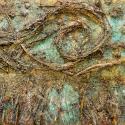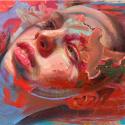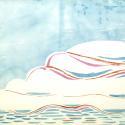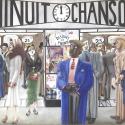The work of the photographer, theatrical designer, narcissist, snob, careerist, and exceptionally talented Cecil Beaton (1904-1980), including 18,000 vintage prints, negatives and transparencies, contact sheets and 45 books of cuttings are at the Victoria & Albert Museum. They have all been brilliantly culled for the alluring and significant exhibition of some of Beaton’s royal portraits, billed as A Diamond Jubilee Celebration.
Sir Roy Strong put Beaton firmly back on the map after he had gone out of fashion with a dazzling 1968 compilation at the National Portrait Gallery. He is firmly of the view that Beaton’s imagery of the royals saved the royals as far as the public were concerned after the debacle of the Abdication. Indeed, Queen Elizabeth the Queen Mother wrote to Beaton in 1963 thanking him for “producing us as really quite nice and real people”. "Producing" is the operative verb: Beaton staged the royals. The V&A’s presentation shows us just how much Beaton has made his view of the royals ours.
 It was Beaton’s rapport in the late 1930s with the Queen Mother (then Queen) that led on quite naturally to his being in effect for many years the royal photographer: he began by portraying this Elizabeth as an idealised romantic creature, hardly of this earth, and went on in wartime to show her daughter, the young Princess Elizabeth, in uniform, an image which was on the cover of Life magazine in February 1943. The exhibition even includes Princess Elizabeth’s broadcast on Children’s Hour to her fellow children in times of war. Beaton photographed the effects, internal and external, of the nine direct hits from German bombs on the Palace. Visitors are reminded of her mother’s stirring public declaration during the Blitz when children were being evacuated out of the war zones: “The children won’t go without me, I won’t go without the King, and the King will never leave.”
It was Beaton’s rapport in the late 1930s with the Queen Mother (then Queen) that led on quite naturally to his being in effect for many years the royal photographer: he began by portraying this Elizabeth as an idealised romantic creature, hardly of this earth, and went on in wartime to show her daughter, the young Princess Elizabeth, in uniform, an image which was on the cover of Life magazine in February 1943. The exhibition even includes Princess Elizabeth’s broadcast on Children’s Hour to her fellow children in times of war. Beaton photographed the effects, internal and external, of the nine direct hits from German bombs on the Palace. Visitors are reminded of her mother’s stirring public declaration during the Blitz when children were being evacuated out of the war zones: “The children won’t go without me, I won’t go without the King, and the King will never leave.”
As for the photographs - beautifully printed vintage prints almost entirely in black and white, of uncanny clarity - we are shown the skilful artifice behind the poses (pictured above right, Queen Elizabeth II, 1968, by Beaton), the theatrical backdrops, the choices among the 775 rooms of Buckingham Palace (the White Drawing Room, the Blue Drawing Room, the Music Room) and the evolution of a style. Romanticism (shades of Winterhalter) gave way to a surprising informality even in the group photographs back home at the Palace after the 1953 Coronation.
The Queen as a young mother was posed with an apparent but carefully contrived ease, and even royal babies in their cots do look like – well, babies. And then there is a surprisingly minimal, even austere style, pared down, dignified and graceful, the Queen in a strikingly simple cloak as Lord High Admiral (a title she has just passed on to the Duke of Edinburgh, a real sailor, as a 90th-birthday present), her striking silhouette set against a plain white background. Throughout the royals used Beaton’s photographs as gifts, both personal and official, choosing from the photographer’s contact sheets (pictured below).
 The propaganda – a series of images of a woman selflessly devoted to country and family – is subtle and effective, and a significant step away from the subsequent decades of intrusiveness that have injured, perhaps irreparably, the royals’ current standing. Beaton still has some lessons for younger generations: a firm aesthetic, distinctive and intelligent setting and pose. The photographer controlled his own image, too: there is a sequence of portraits of Beaton himself, from Paul Tanqueray to Curtis Moffat. An open Visitors Book from 1951 shows that from April to May his guests included Henri Cartier-Bresson, Margaret Lockwood, Lucian Freud, Francis Bacon and Frederick Ashton. There is a clip from a television programme made about Beaton by David Bailey, no less, in which the master says he was told when a young man in his twenties not to worry about his career, just to become a friend of the Sitwells. And so it came to pass. The rest is photographic history.
The propaganda – a series of images of a woman selflessly devoted to country and family – is subtle and effective, and a significant step away from the subsequent decades of intrusiveness that have injured, perhaps irreparably, the royals’ current standing. Beaton still has some lessons for younger generations: a firm aesthetic, distinctive and intelligent setting and pose. The photographer controlled his own image, too: there is a sequence of portraits of Beaton himself, from Paul Tanqueray to Curtis Moffat. An open Visitors Book from 1951 shows that from April to May his guests included Henri Cartier-Bresson, Margaret Lockwood, Lucian Freud, Francis Bacon and Frederick Ashton. There is a clip from a television programme made about Beaton by David Bailey, no less, in which the master says he was told when a young man in his twenties not to worry about his career, just to become a friend of the Sitwells. And so it came to pass. The rest is photographic history.
- Queen Elizabeth II by Cecil Beaton: A Diamond Jubilee at the V&A until 22 April, sponsored by Garrard





![SEX MONEY RACE RELIGION [2016] by Gilbert and George. Installation shot of Gilbert & George 21ST CENTURY PICTURES Hayward Gallery](/sites/default/files/styles/thumbnail_125_x_125_/public/mastimages/Gilbert%20%26%20George_%2021ST%20CENTURY%20PICTURES.%20SEX%20MONEY%20RACE%20RELIGION%20%5B2016%5D.%20Photo_%20Mark%20Blower.%20Courtesy%20of%20the%20Gilbert%20%26%20George%20and%20the%20Hayward%20Gallery._0.jpg?itok=3oW-Y84i)









Add comment